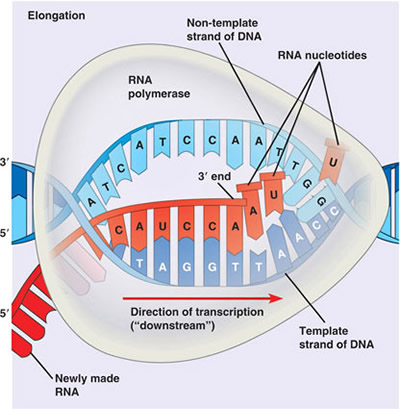DNA is a highly coiled polymer, 2 metres of which tightly packs into a nucleus. This highly coiled polymer contains the genetic code.
Transcription takes place in the nucleus and is the process by which a copy of a segment of DNA code, known as a gene, is made. This copy is known as messenger RNA (mRNA).
An enzyme, RNA polymerase, unzips the DNA helix and links together the nucleotides to make a mRNA molecule as it works its way along the DNA strand from the 3' to the 5' end.
Click to see an explanation of the terminology 3' to the 5'.
Click to go back to the transcription image

The video on the right gives a quick overview of the process of transcription.
A strand of DNA that codes for a protein is known as a
RNA and DNA are very similar. In RNA the thymine, mentioned as "T" in the video, is replaced by
DNA is where as RNA is
DNA is made of and RNA is
DNA contains and RNA contains
.
What is the function of the enzyme RNA Polymerase?
RNA Polymerase reads the DNA code from the
The RNA grows from its
The video mentions ribonucleoside triphosphate monomers. Read the chapter below.
DNA and RNA polymers are synthesized using nucleoside triphosphate monomers as precursors. During DNA and RNA synthesis, two of the phosphate groups of the incoming nucleoside triphosphate are removed. This cleavage of the triphosphates provides the energy needed to power the polymerisation reaction. The remaining phosphate,together with the nucleoside form the nucleotide monophosphate and takes its place in the sugar-phosphate backbone of the growing nucleic acid chain. A pyrophosphate molecule (two linked phosphates) is released.
Generally, nucleosides are nucleotides that lack phosphates.
Explain the reason why ribonucleoside triphosphate monomers are used in the process of nucleic acid synthesis when only a monophosphate is needed.